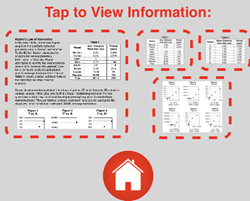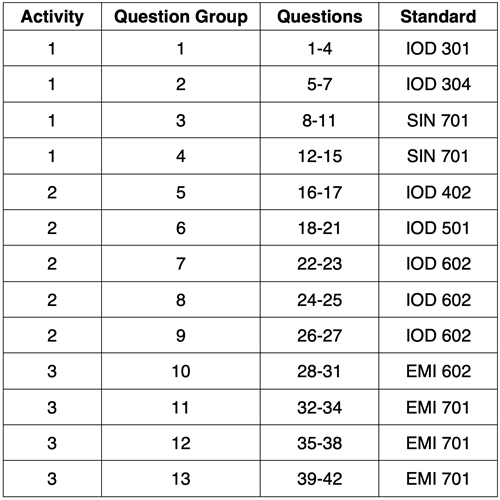About the Science Reasoning Center
 Highly Recommended
Highly RecommendedLike all our Science Reasoning Center activities, the completion of the Kepler's Third Law activity requires that a student use provided information about a phenomenon, experiment, or data presentation to answer questions. This information is accessible by tapping on the small thumbnails found on the bottom right of every question. However, it may be considerably easier to have a printed copy of this information or to display the information in a separate browser window. You can access this information from this page.
The Standards
The Kepler's Third Law activity describes an exercise in which students analyze period-radius data for the orbit of the (traditional) nine planets. The information is presented in the form of a data table and six different graphs of period and radius raised to various powers. Questions target a student's ability to understand the linear regression process, to recognize patterns in the data and graphs, to identify the relationship between the two variables, and to use the relationship to make predictions about the radius ratio or period ratio for planets in a fictional solar system.
Success with the activity requires some degree of proficiency with respect to ...
- Developing and Using Models (Science and Engineering Practice 2.1)
Evaluate merits and limitations of two different models of the same proposed tool, process, mechanism, or system in order to select or revise a model that best fits the evidence or design criteria. - Planning and Carrying Out Investigations (Science and Engineering Practice 3.5)
Make directional hypotheses that specify what happens to a dependent variable when an independent variable is manipulated. - Analyzing and Interpreting Data (Science and Engineering Practice 4.2)
Apply concepts of statistics and probability (including determining function fits to data, slope, intercept, and correlation coefficient for linear fits) to scientific and engineering questions and problems, using digital tools when feasible. - Using Mathematics and Computational Thinking (Science and Engineering Practice 5.3)
Use mathematical, computational, and/or algorithmic representations of phenomena or design solutions to describe and/or support claims and/or explanations. - Obtaining, Evaluating, and Communicating Information (Science and Engineering Practice 8.5)
Communicate scientific and/or technical information or ideas (e.g. about phenomena and/or the process of development and the design and performance of a proposed process or system) in multiple formats (including orally, graphically, textually, and mathematically). - Patterns (Crosscutting Concept 1.5)
Mathematical representations are needed to identify some patterns.
While the Kepler's Third Law activity addresses the five NextGen Science and Engineering Practices and the crosscutting concept above, the activity drew its greatest inspiration from ACT's College Readiness Standards for Science Reasoning. The activity consists of 42 questions organized into 13 Question Groups that are spread across the three activities. Most questions address standards in the Interpretation of Data (IOD) strand. A few questions address data from the Evaluation of Models, Inferences, and Experimental Results (EMI) strand and the Scientific Investigation (SIN) strand of the College Readiness Standards. The code given for the standard includes three letters to indicate the strand and three numbers to indicate the specific standard within that strand. Higher numbers are indicative of more complex science reasoning skills. The relationship between the questions and the standards is as follows:

Complementary and Similar Resources
The following resources at The Physics Classroom website complement the Kepler's Third Law Science Reasoning Activity. Teachers may find them useful for supporting students and/or as components of lesson plans and unit plans.
Physics Classroom Tutorial, Circular and Satellite Motion Chapter: Kepler's Three Laws
Physics Video Tutorial, Circular and Satellite Motion: Kepler's Three Laws
Physics Video Tutorial, Circular and Satellite Motion: Satellite Motion Math
Physics Interactives, Circular Motion and Gravitation: Orbital Motion Simulation
Minds On Physics, Circular Motion and Gravitation Module, Mission CG10: Kepler's Laws
The Calculator Pad, Circular Motion Chapter, Problem Sets CG16 - CG18
Recommended: Print Passage, Tables, and Graphs
Also see: